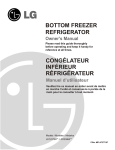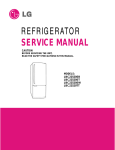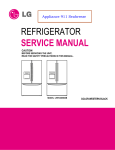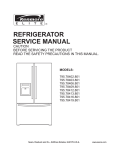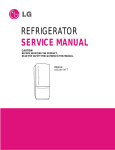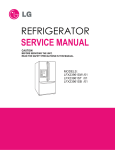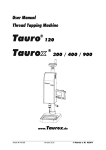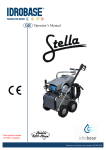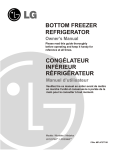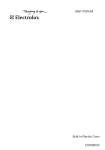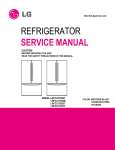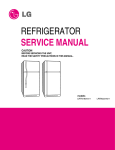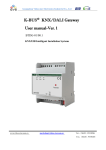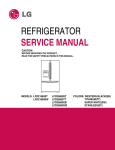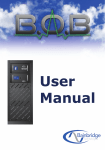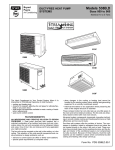Download 3. disassembly
Transcript
REFRIGERATOR SERVICE MANUAL CAUTION BEFORE SERVICING THE UNIT, READ THE SAFETY PRECAUTIONS IN THIS MANUAL. MODELS: LFC23760ST / 04 LFC23760SW / 04 LFC23760SB / 04 ECN (Engineering Change Number) Rev.01 Change Cover Lower (improve structure) SVC Improvement opening door freezer (Change connector rail in order to reduce claims for bad sealing and door misaligned. New connector rail has 1º degree of inclination) Rev.02 Valve inclined in order to improve house connection Rev.03 Change model to Barrierless type & Twisting Ice Maker Rev.04 Compressor change from MQ53LAUM (PTC) to MQ53LAUM (e-PTC) CONTENTS SAFETY PRECAUTIONS ........................................................................................................ 3 1. SPECIFICATIONS ............................................................................................................... 4 2. PARTS IDENTIFICATION .................................................................................................... 5 3. DISASSEMBLY ................................................................................................................... 6 3-1 Fan and Fan Motor.......................................................................................................... 6 3-2 Defrost Control Assembly................................................................................................. 6 3-3 Lamp................................................................................................................................ 6 3-4 Control Box Refrigerator.................................................................................................. 7 3-5 Multiduct.......................................................................................................................... 7 3-6 Cover Valve...................................................................................................................... 9 3-7 Door Disassembly............................................................................................................ 10 3-8 How to remove the Door Handle..................................................................................... 12 3-9 How to remove Pull out drawer........................................................................................ 14 3-10 Closing and aligning the doors...................................................................................... 16 4. ADJUSTMENT .................................................................................................................... 17 4-1 Compressor ................................................................................................................... 17 4-2 PTC-Starter .................................................................................................................... 17 4-3 OLP (overload protector) ............................................................................................... 18 5. CIRCUIT DIAGRAM ............................................................................................................ 19 6. TROUBLESHOOTING ........................................................................................................ 20 6-1 Compressor and electric components ........................................................................... 20 6-2 PTC and OLP ................................................................................................................. 21 6-3 Other electrical components .......................................................................................... 22 6-4 Service diagnosis chart .................................................................................................. 23 6-5 Refrigeration cycle ......................................................................................................... 24 7. OPERATION PRINCIPLE AND REPAIR METHOD OF ICEMAKER .................................. 26 7.1 Operation principle ......................................................................................................... 26 7.2 Ice maker functions ........................................................................................................ 27 8. CIRCUIT OF MICOM............................................................................................................ 30 8.1 Function ......................................................................................................................... 30 8.2 PCB function .................................................................................................................. 34 8.3 Resistance specification of sensor ................................................................................. 38 9. EXPLODED VIEW ............................................................................................................... 39 -2- SAFETY PRECAUTIONS Please read the following instructions before servicing your refrigerator. 1.Check the refrigerator for current leakage. 2.To prevent electric shock,unplug before servicing. 3.Always check line voltage and amperage. 4.Use standard electrical components. 5.Don't touch metal products in the freezer with wet hands.This may cause frost bite. 7.Before tilting the refrigerator, remove all materials from on or in the refrigerator. 8.When servicing the evaporator, wear gloves to prevent injuries from the sharp evaporator fins. 9.Service on the refrigerator should be performed by a qualified technician.Sealed system repair must be performed by a CFC certified technician. 6.Prevent water from spiling on to electric elements or the machine parts. -3- SPECIFICATIONS Color MODELS 1. SPECIFICATIONS LFC23760SW /04 LFC23760ST /04 LFC23760SB /04 Super White Stainless Black 892 (W) x 925 (D) x 1860 (H) mm Dimensions Net Weight 123 Kg Capacity 23 cuft Refrigerant R134a Climate class Temperate (T) Rated Rating 115V~ / 60Hz GENERAL FEATURES Cooling System Fan Cooling Temperature Control MICOM control Full Automatic Defrosting System Heater Defrost Insulation Cyclo, Pentane Compressor MQ53LAUM PTC Starting Type Evaporator Fin Tube Type Condenser Wire Condenser Lubricanting Oil Polyol Ester (POE) RL-7H/7 cst 220 ± 10cc Drier MOLECULAR SIEVE XH-7 Capillary Tube ID Ø0.75 First Defrost 4 Hours Defrost Cycle 7 - 40 Hours Desfrosting Device Heater, Sheath Anti-freezing Heater Water Tank Heater Case Material FREEZER REFRIGERATOR Door Material Embo (normal) PCM Stainless Handle Type Vista Display Graphic ICE PLUS Basket, Quantity 3 left + 3 right Ice Tray & Bank 1B/(1EA) Lamp Yes (2) 40W/Blue Shelf 1Fix(S/Proof)+1Fold+2S/Out(S/Proof) Tray meat No Egg Bank Yes (Cover + Egg tray) Basket, Quantity No Lamp Yes (1) 40W/Blue Shelf No -4- VCM DIMENSIONS Description LFC23760** Depth w/ Handles A 34 5 8 Depth w/o Handles B 32 1 8 Depth w/o Door C 28 ¼ Depth (Total with Door Open) D 45 ½ Height to Top of Case E 67 11 Height to Top of Door Hinge F 69 1 Width G 32 ¾ Width (door open 90 deg. w/o handle) H 36 ¼ Width (door open 90 deg. w/ handle) I 41 ¼ 16 16 2. PARTS IDENTIFICATION A L B C M D E N F G H O I P J K Read this section to familiarize yourself with the parts and features of your new refrigerator. NOTE: This guid ecovers different models. Your refrigerator could have some or all of the features and parts listed below. The location of some of the parts may not correspond to that of your model. A Digital Sensor Control * I Ice Bin B Refrigerator Light J Durabase C Shelves K Durabase Divider D Temperature Control * L Dairy Compartment E Chef Fresh / Snack Pan M Egg Compartment * F Can Dispenser * N Refrigerator Door Rack G Optibin Crisper Keeps fruits and vegetable fresh and crisp O Freezer Light P Pull out Drawer H Icemaker * On some models -5- A K B C L D M E F G N H O I J Read this section to familiarize yourself with the parts and features of your new refrigerator. NOTE: This guid ecovers different models. Your refrigerator could have some or all of the features and parts listed below. The location of some of the parts may not correspond to that of your model. A Digital Sensor Control * I Durabase B Refrigerator Light J Durabase Divider C Shelves K Dairy Compartment D Chef Fresh / Snack Pan L Egg Compartment * E Can Dispenser * M Refrigerator Door Rack F Optibin Crisper Keeps fruits and vegetable fresh and crisper N Freezer Light O Pull out Drawer G Icemaker H Ice Bin * On some models -6- 3. DISASSEMBLY 3-1 FAN AND FAN MOTOR 3-3 LAMP 1. Remove the freezer shelf. (If your refrigerator has an icemaker, remove the icemaker first). 2. Remove the plastic guide for slides on left side by unscrewing phillips head screws. 3. Remove the grille by removing one screw and pulling the grille forward. 4. Remove the Fan Motor assembly by loosening 2 screw and disassemble the shroud. 5. Pull out the fan and separate the Fan Motor and Bracket. 3-3-1 REFRIGERATOR COMPARTMENT LAMP 1. Unplug your refrigerator. 2. Pull out all of the shelves. 3. Slide a flat screwdriver (1) into the opening of the light bulb, and pull it downwards (2). 1 2 FAN MOTOR 4. Turn the bulb counter clockwise and remove it. 5. Install the new light bulb. 6. Take the cover (1), lock the hooks (2) from the rear part of the light bulb and push it upwards (3). BRACKET MOTOR FAN 2 GRILLE 1 3-2 DEFROST CONTROL ASSEMBLY 3 Defrost Control assembly consist of Drefrost Sensor and FUSE-M. The Defrost Sensor works to defrost automatically. It is attached to the metal side of the Evaporator and senses its temperature. Fuse-M is safety device for preventing over-heating of the Heater when defrosting. At 72°C, it turns the Defrost Heater off. 1. Pull out the grille assembly. (Fig. 1) 2. Separate the connector with the Defrost Control assembly and replace the Defrost Control assembly after cutting the Tie Wrap. (Fig. 2) GRILLE ASSEMBLY 3-3-2 FREEZER COMPARTMENT LAMP 1. Unplug refrigerator. 2. Unlock the cover of the light bulb using your thumbs (2). 1 2 3. Remove the light bulb and replace it with a new one. 4. Take the cover (3), lock the hooks of it (4) and push it upwards (5). 5. Plug the refrigerator back in. DEFROST-CONTROL ASSEMBLY 4 Fig. 1 Fig. 2 3 -7- 5 3-4 CONTROL BOX-REFRIGERATOR 1. First, remove all shelves in the refrigerator, than remove the Refrigerator control Box by loosening 2 screws. CONTROL BOX COVER LAMP 2. Remove the Refrigerator Control Box by pulling it downward. 3. Disconnect the lead wire on the right position and separate the lamp sockets. 3-5 MULTI DUCT 1. Remove an upper and lower Cap by using a flat screwdriver, and loosen 2 screws. 2. Disconnect the lead wire on the botton position. -8- 3-6 VALVE COVER (in some models) 3-6-1 DISASSEMBLE 3-6-2 ASSEMBLE 1. Unscrew the back cover. 1. Insert the ribs to the right side of the back cover hole. 2. Unscrew the valve cover from the back side. 2. Screw the valve cover from the back side. 3. Push to the left and release. 3. Screw the back cover. -9- 3-7 DOOR DISASSEMBLY 1. To remove Refrigerator door IMPORTANT: Before you begin, turn the refrigerator OFF and Unplug it. Remove all food and the shelves from the doors. Right Door Left Door 5 NOTE: The appearance of the handle might be different. With the Philips screw driver, loose the two screws from the upper lid (1) remove it after that. 1 Unplug the switches cable (6) it’s optional, it’s no neccesary do it for removing the door. Unplug the switches cable (2) it’s optional, it’s no neccesary do it for removing the door. 6 Unplug the cable harness pulling up the hook located in the upper part of it (7) and separate both parts of the harness (8). 2 With the 10mm socket wrench, loose the two pins from the hinge (3) and remove it (4). Upper view of the harness 3 4 Place the door with the inner face over the surface so it won't scratch. - 10 - 3 Front view of the harness Right Door 7 2 8 Loose the grounding screw (9) and the pins (10) located over the hinge, after, lift the hinge and remove it (11). Place the hinge in its original position (4) assembly the two pins (5) and the ground screws (6). 10 5 11 4 9 6 Remove the door and place it over its inner face to avoid scratching. Plug the cable harness (7) and the switch (8) (just in case if you unplugged the switch). 2. To install Refrigerator door Right Door 7 Take the door and place it gently over the pin of the hinge (1). 8 1 Pin Place the hinge lid (9) and install both screws (10). Be sure the door is correctly assembled. 10 9 Be sure the hook (2) (located in the upper part of the door) matches with the divisor of the refrigerator's door (3). Check that the sealing patch of the door is leveled to the refrigerator and that it isn´t bended. - 11 - Plug the cable to the switch (16) (just in case if you unplugged the switch). Left Door Take the left door and place it over the hinge (11). 11 16 Place the hinge's lid (17) and screw the two screw (18). Check that the door is well installed. 18 17 Be sure that the hook (12) located in the upper part of the door) matches with the splitter of the refrigerator (13). Check that the sealing patch of the door ends leveled with the refrigerator and that it isn't bended. 13 Left Door 3-8 HOW TO REMOVE DOOR HANDLE Loose the screws (1) with the Allen tool 3/32” and remove the handle (2). Remove the mounting screws with the ¼” Allen tool (3). 12 Mounting Screws 3 Screws Place the hinge in its original position (14) and place the two screws (15). 1 2 15 14 Allen Wrench - 12 - 1. To install the handle of the refrigerator 3. To install the freezer's handle Install the mounting screws over the door (1) place the handle over them (2) and tight the screws up (3). Install the mounting screws over the door (1) place the handle over them (2) and tight the screws up (3). Mounting Screws 1 1 Screws 1 2 3 2 3 Allen Wrench 2. To remove the freezer's handle With an 3/32” Allen tool, loose the screws (1) located on the bottom of the handle, remove it (2) remove the screws from the door (3) with an ¼” Allen tool. 3 3 2 1 - 13 - 3-9 HOW TO REMOVE PULL OUT DRAWER IMPORTANT: To avoid possible injury or damage to the product or your property, please use two people to perform • With both hands, hold both sides of the door and pull up to separate it. the following instructions: 1. Removing the Pull Out Drawer • Pull the drawer out to maximum extension. Remove the bottom rack (1) by tilting it back a little and then lifting it off the railing tracks. 1 • With both hands, hold the center of the bar and push it in so that it is fit to both rails simultaneously. • Put pressure on the two hangers (2) with your thumbs in order to lift it up. • Separate the left and right rail cover. CAUTION: When removing the drawer, do not hold the handle. If it comes off, it could cause personal injury. CAUTION: To place the drawer on the floor, take care not to damage the floor or hurt your feet with the sharp edges on the side with the hinges. 2 2. Installing the Pull Out Drawer • Remove the screws (3) from both sides of the rail track. 3 • With both hands, hold the center of the bar and pull it outward so that the two rails extend out at the same time. - 14 - • Mount door supports (1) into the tabs on the railing track (2), starting in the back first and then connecting the part in the front last, as shown in the figure. • Align the top holes of the rail cover with the top holes of the door supports to mount the cover. 1 2 Verify the hole’s alignment • Push the drawer down into position and tighten the screws (3). 3 • With the drawer fully extended, insert the lower basket over the front part of the rail assembly and then the back part (4). • Compare the left and right rail covers on each side. 4 Right Rail Left Rail WARNING: To prevent entrapment risk and accidental child or animal suffocation, DO NOT permit them to play inside of the drawer. WARNING: DO NOT step ot sit on the Freezer Door. - 15 - 3-10 CLOSING AND ALIGNING THE DOORS Closing the Doors Aligning the Doors Your refrigerator has two front leveling screws, one on the right and one on the left. If your refrigerator seems unstable or if you would like the doors to close more easily, simply adjust the inclination of the refrigerator by following the instructions below: If the spacing between the doors is uneven, follow the instructions below to align them: 1. Plug the refrigerator into a 3 prong grounded outlet. Move the refrigerator into its final position. 2. Remove the base grille (Refer to the section on “Installation of Base Grille”). 1. With one hand, lift up the door you want to raise at middle hinge. 2. With other hand, use pliers to insert snap ring as shown. 3. Insert additional snap rings until the doors are aligned. (Three snap rings are provided per unit.) 3. Use a flat head screwdriver to adjust the leveling screws, turning clockwise to raise the side of the refrigerator and counter-clockwise to lower it. It may take several turns to adjust it to the inclination you would like. NOTE: Having someone push against the top of the refrigerator takes some weight off the leveling screws. This will make it easier to adjust the screws. 4. Open both doors again and check to make sure that they close easily. If not, slightly tilt the refrigerator further back by turning both leveling screws clockwise. It may take several more turns. Make sure that you turn both leveling screws the same amount. 5. Ensure that the refrigerator is even by using a level. 6. Replace the base grille. - 16 - 4. ADJUSTMENT 4-1 COMPRESSOR 4-2-3 PTC-Applied Circuit Diagram Starting Method for the Motor 4-1-1 Role The compressor intakes low temperature and low pressure gas from the evaporator of the refrigerator and compresses this gas to high-temperature and high-pressure gas. It then delivers the gas to the condenser. OVERLOAD PROTECTOR L1 C 4-1-2 Composition 2 The compressor includes overload protection. The PTC starter and OLP (overload protector) are attached to the outside of the compressor. Since the compressor is manufactured to tolerances of 1 micron and is hermetically sealed in a dust and moisture-free environment, use extreme caution when repairing it. PTC 5 S 3 6 N COMPRESSOR MOTOR M S M C PTC STARTER SEALED TERMINAL Resistance Starter Capacitor Running 4-1-3 Note for Usage Fig. 1 (1) Be careful not to allow over-voltage and over-current. (2) If compressor is dropped or handled carelessly, poor operation and noise may result. (3) Use proper electric components appropriate to the Particular Compressor in your product. (4) Keep Compressor dry. If the Compressor gets wet (in the rain or a damp environment) and rust forms in the pin of the Hermetic Terminal, poor operation and contact may result. (5) When replacing the Compressor, be careful that dust, humidity, and soldering flux don’t contaminate the inside of the compressor. Dust, humidity, and solder flux contaminate the cylinder and may cause noise, improper operation or even cause it to lock up. 4-2-4 Motor Restarting and PTC Cooling (1) It requires approximately 5 minutes for the pressure to equalize before the compressor can restart. (2) The PTC device generates heat during operation. Therefore, it must be allowed to cool before the compressor can restart. 4-2-5 Relation of PTC-Starter and OLP (1) If the compressor attempts to restart before the PTC device is cooled, the PTC device will allow current to flow only to the main winding. (2) The OLP will open because of the over current condition. This same process will continue (3 to 5 times) when the compressor attempts to restart until the PTC device has cooled. The correct OLP must be properly attached to prevent damage to the compressor. Parts may appear physically identical but could have different electrical ratings. Replace parts by part number and model number. Using an incorrect part could result in damage to the product, fire, injury, or possibly death. 4-2 PTC-STARTER 4-2-1 Composition of PTC-Starter (1) PTC (Positive Temperature Coefficient) is a no-contact semiconductor starting device which uses ceramic material consisting of BaTiO3. (2) The higher the temperature is, the higher the resistance value. These features are used as a starting device for the Motor. 4-2-6 Note for Using the PTC-Starter (1) Be careful not to allow over-voltage and over-current. (2) Do not drop or handle carelessly. (3) Keep away from any liquid. If liquid such as oil or water enters the PTC, PTC materials may fail due to breakdown of their insulating capabilities. (4) If the exterior of the PTC is damaged, the resistance value may be altered. This can cause damage to the compressor and result in a no-start or hard-to-start condition. (5) Always use the PTC designed for the compressor and make sure it is properly attached to the compressor. Parts may appear physically identical but could have different electrical ratings. Replace parts by part number and model number. Using an incorrect part could result in damage to the product, fire, injury, or possibly death. 4-2-2 Role of PTC-Starter (1) The PTC is attached to the Sealed Compressor and is used for starting the Motor. (2) The compressor is a single-phase induction motor. Durign the starting operation, the PTC allows current flow to both the start winding and main winding. - 17 - 4-3 OLP (OVERLOAD PROTECTOR) 4-3-1 Definition of OLP (OVERLOAD PROTECTOR cross section) (1) OLP (OVERLOAD PROTECTOR) is attached to the Compressor and protects the Motor by opening the circuit to the Motor if the temperature rises and activating the bimetal spring in the OLP. 12345678 Electrical characteristics part number 330 FBYY -S1 BOX98 Customer part number Lot code/ date code Physical termination part number (2) When high current flows to the Compressor motor, the Bimetal works by heating the heater inside the OLP, and the OLP protects the Motor by cutting off the current flowing to the Compressor Motor. 4-3-2 Role of the OLP (1) The OLP is attached to the Sealed Compressor used for the Refrigerator. It prevents the Motor Coil from being started in the Compressor. Part No. Name Base, phenolic (UL 94 V-0 rated) Movable arm support, plated steel. Stationary contact support, plated steel Heater support, plated steel Heater, resistance alloy Disc, thermostatic alloy (2) For normal operation of the OLP, do not turn the Adjust Screw of the OLP in any way. Movable arm, spring temper copper alloy Contact, movable, silver on copper Contact, stationary, silver on copper Slug, plated steel Cover, polyester (UL 94 V-0 rated) Pin connector, plated copper alloy (To engage 2.33/2.66 mm dia. pin) Fig. 2 - 18 - 5. CIRCUIT DIAGRAM CIRCUIT DIAGRAM - 19 - 6. TROUBLESHOOTING 6-1. COMPRESSOR AND ELECTRIC COMPONENTS 1 Power Source. Remove PTC-Starter from compressor and measure voltage between Terminal C of compressor and terminal 5 or 6 of PTC. YES (Rated voltage 2 YES No voltage. 5 Reconnect. NO Check connection condition. Replace OLP. Applied voltage isn't in acceptable range. (115V ±10%) 2 Check Check resistance resistance of of motor motor compressor. compressor. . Advise customer that power supply needs to be checked by an electrician. 5 The range of resistance is between 1~50 ? (ok) Check the resistance between M-C, S-C and Replace M-S in motor compressor. Open or short compressor 3 Check resistance of PTC-Starter. Check resistance of two terminals in PTC-Starter. At normal temperature 6.8? +20: OK 4 Check OLP. Check resistance of two terminals in OLP. If power conducts: OK If not: NG 5 Check starting state. Check the power supply under load. (Compressor attempting to re-start after being off for 5 minutes). Supply voltage rating with ±10%. YES 3 Did compressor 4 YES 3 5 Compressor is OK Replace the NO compressor NO - 20 - 1 6-2. PTC AND OLP Separate PTC-Starter from Compressor and measure resistance between No. 5 and 6 of PTC-Starter with a Tester. (Figure 1) Observation value is 115V/60Hz : 6.8 ? ±20% The resistance value is 0 ? (short) or (open). Separate OLP from compressor and check resistance value between two terminals of OLP whit a tester. (Figure 2) Shows continuity Open Check another electric component. Replace OLP. 5 6 Normal operation of compressor is impossible or poor. ? Figure 1 - 21 - Figure 2 Replace PTCStarter. 6-3 OTHER ELECTRICAL COMPONENTS • Not cooling at all Compressor doesn't run. Check for open short or incorrect resistance readings in the following components Cause a. Starting devices Short, open, or broken. b. OLP Poor contact or shorted. c. Compressor coil Coil open or shorted. d. Wiring harness Poor contact or shorted. Replace indicated component. • Poor cooling performance Compressor runs poorly. Check starting voltage. Low voltage. Advise customer that the power supply needs to be checked by an electrician. Fan motor doesn't run. Check voltage at starting devices. Poor or broken or open contact. Check current flowing in sub-coil of Compressor. Shorted. Check rating of OLP. Lack of capacity. Check wiring circuit. Wire is open or shorted. Replace indicated component. Coil is shorted or open. Check Fan Motor. Heavy frost buildup on evaporator Replace indicated component. Check current flow in the following components: Sensor Fuse-M Check current flow in the defrost heater. - 22 - Open. Replace indicated component. Open. Replace defrost heater. 6-4 SERVICE DIAGNOSIS CHART COMPLAINT POINTS TO BE CHECKED REMEDY No Cooling. • • Check if the power switch is set to OFF. • Check if the fuse of the power switch is shorted. • Measure the voltage of the power outlet. • Plug into the outlet. • Set the switch to ON. • Replace the fuse. • If the voltage is low, correct the wiring. Cools poorly. • Check if the unit is placed too close to the wall. • Check if the unit is placed too close to the stove, gas cooker, or in direct sunlight. • Is the ambient temperature too high or • Place the unit about 4 inches (10 cm) from the wall. • Place the unit away from these heat sources. • Check if food put in the refrigerator is hot. • Did you open the door of the unit too often • Put in foods after they have cooled down. • Don't open the door too often and close it firmly. • Set the control to Recommended position. • Check if the Control is set to Warm position. Foods in the Refrigerator are frozen. • • Check if the control is set to colder position. • Is the ambient temperature below 41°F(5° • Lower the ambient temperature. • Place foods in the high-temperature section. (front part) • Set the control to Recommended position. • Set the control to Warm position. Condensartion or ice forms inside the unit. • • Check if food put in the refrigerator is hot. • Did you open the door of the unit too • Seal liquid foods with wrap. • Put in foods after they have cooled down. • Don't open the door too often and close it firmly. Condensartion forms in the Exterior Case. • Check if the ambient temperature and humidity of the surrounding air are high. • • Wipe moisture with a dry cloth. It will disappear in low temperature and humidity. • Fill up the gap. There is abnormal noise. • • Adjust the Leveling Screw, and position the refrigerator in a firm place. • Remove the objects. • Are any unnecessary objects placed Door does not close well. • Check if the Tray Drip is not firmly fixed. • Check if the cover of the compressor enclosure in the front lower side is taken out. • Fix the Tray Drip firmly in the original position. • Place the cover in its original position. • Check if the door gasket is dirty with an item like juice. • • Clean the door gasket. • Position in the firm place and level the Leveling Screw. • Make sure food stored in shelves does not prevent the door from closing. • Ice and foods smell unpleasant. • Check if the inside of the unit is dirty. • • The unit smells of plastic. • Clean the inside of the unit. • Wrap foods that have a strong odor. • New products smell of plastic, but this will go away after 1-2 weeks. • Other possible problems: Check if frost forms in the freezer. Not defrosting Check Components of the defrosting circuit. Check the refrigeration system. The system is faulty. Perform sealed system repair. Check the Thermistor. The operation of the Thermistor is incorrect. - 23 - Replace the Thermistor. 6-5 REFRIGERATION CYCLE • Troubleshooting Chart STATE OF THE UNIT STATE OF THE EVAPORATOR PARTIAL LEAKAGE Freezer compartment and refrigerator don’t cool normally Low flowing sound of refrigerant is heard and frost forms in inlet only. COMPLETE LEAKAGE Freezer compartment and refrigerator don’t cool normally Flowing sound of refrigerant is not heard and frost isn’t formed. Freezer Flowing sound of refrigerant is heard and frost forms in inlet only. CAUSE TEMPERATURE OF THE COMPRESSOR REMARKS LEAKAGE RESTRICTION A little higher than ambient temperature. - Refrigerant level is low due to a ¥ leak. - Normal cooling is possible by restoring the normal amount of ¥ refrigerant and repairing the leak. ¥ Equal to ambient temperature. - No discharging of refrigerant. - Normal cooling is possible by restoring the normal amount of ¥ refrigerant and repairing the leak. ¥ A little higher than ambient temperature. - Normal discharging of the refrigerant. ¥ - The capillary tube is faulty. Flowing sound of refrigerant is not heard and frost isn’t formed. Equal to ambient temperature. - Normal discharging of the refrigerant. ¥ Cooling operation stops periodically. Flowing sound of refrigerant is not heard and frost melts. Lower than ambient - Cooling operation restarts when ¥ heating the inlet of the capillary temperature. tube. ¥ COMPRESSION Freezer and refrigerator don’t cool. Low flowing sound of refrigerant is heard and frost forms in inlet only. A little higher than ambient temperature. - Low pressure at high side of compressor due to low ¥ refrigerant level. ¥ NO COMPRESSION No compressing operation. Flowing sound of refrigerant is not heard and there is no frost. Equal to ambient temperature - No pressure in the high pressure part of the compressor. ¥ ¥ PARTIAL compartment and RESTRICTION refrigerator don’t cool normally Freezer COMPLETE compartment and RESTRICTION refrigerator don’t cool. MOISTURE RESTRICTION DEFECTIVE COMPRESSION - 24 - 6-5-1 SEALED SYSTEM DIAGNOSIS Not Cooling Complaint All components operating, No airflow problems, Not frosted up as a defrost problem problem has been isolated to sealed system area Frost Pattern? Partial None Equalization Test Equalization Test Very Fast Very Slow Very Slow Very Fast Fast Inefficient Compressor Partial Restriction Complete Restriction Condenser Temperature Cap Tube Sound Hotter than Normal Faint Room Temperature None to Weak Air/Low Side Leak Loss of Change Compressor Not Pumping Trace of Oil Yes No Leak Undercharge (The equalization test is trying to restart a compressor after it has been operating.) - 25 - 7. OPERATION PRINCIPLE AND REPAIR METHOD OF ICEMAKER 7-1 OPERATION PRINCIPLE 7-1-1 Operation Principle of Icemaker Power Input Initial Control • Adjusts Ejector to Start Position with power on. Icemaking Control • Waits until water in the TRAY is frozen after Icemaker Starts operation. Ice Ejection Control • Runs MOTOR to drop ice from the tray into the ICE BIN. Water supply control TEST Control • Performs Icemaking Mode after supplying water by operating the SOLENOID in ICE VALVE. • To operate LINE and SERVICE, press and hold the Fill Key for 3 seconds. The icemaking will run through 3 stages: Harvest Fill Icemaking. 1. Turning the Icemaker stop switch off (O) stops the icemaking function. 2. Setting the Icemaker switch to OFF and then turning it back on will reset the icemaker control. Power Switch Icemaker Feeler Arm - 26 - 7-2 ICEMAKER FUNCTIONS 7-2-1 Start Position 1) When power is initially applied or reapplied after power is cut, it detects level of the TRAY after completion of MICOM initialization. The detecting lever moves up and down. 2) The level of icemaker tray is judged by output signal, high and low signal, of HALL SENSOR. Make the tray to horizontal by rotating ice ejection motor in normal or reverse direction so that High/Low signal can be applied to MICOM Pin (P22). 3) If there is no change in signals one minute after the geared motor starts to operate, it stops icemaker operation and check the signal every hour. It resets initialization of icemaker when it becomes normal. Ice ejection conducts for 1 cycle. 7-2-2 Icemaking Mode a) Ice making control is carried out from the completion of water supply to the completion of ice making in the TRAY. Ice making sensor detects the temperature of TRAY and completes ice making.(Ice making sensor is fixed below the TRAY.) b) Ice making control starts after completion of water supply control or initial control. Under the ice making control, the F room temperature should be operated with the NOTCH of “Normal/Strong”. c) It is judged that ice making is completed when ice making sensor temperature reaches at -8℃ after 70 minutes + 10 minutes when water is supplied to the TRAY. 7-2-3 Ice Ejection Mode a) This is to eject ice from the TRAY after ice making is completed. b) If Hall IC signal is on within 3.6 seconds after ice ejection motor rotates in normal direction, it does not proceed ice ejection but waits. If the ice bank is full, ice ejection motor rotates in normal direction in every hour to check the condition of ice bank. If the ice bank is not full, the water supply control starts after completion of ice ejection control. If the ice bank is full, ice ejection motor rotates in reverse direction and stops under ice making or waiting conditions. c) If ice bank is not full, ice ejection starts. The TRAY tilts to the maximum and ice is separated from the TRAY and ice checking lever raises. d) Ice ejection motor stops for 1 second if Hall IC signal changes from OFF (low) to ON (high) after 3.6 seconds when ice ejection motor rotates in normal direction. If there is no change in Hall IC signals within 1 minute after ice ejection motor operates, ice ejection motor stops as ice ejection motor or hall IC is out of order. e) If ice ejection motor or Hall IC is abnormal, ice ejection motor rotates in normal direction to exercise initial operation in every hour. It resets the ice maker if ice ejection motor or Hall IC is normal. f) The TRAY stops for 1 second at maximum tilted conditions. g) The TRAY returns to horizontal conditions as ice ejection motor rotates in reverse direction. h) When the TRAY becomes horizontal , the cycle starts to repeat. Water Supply – Ice making – Ice ejection – TRAY returns to Horizontal. - 27 - MAXIMUM TILTING POINT Bank is not full ON HALL Sensor Output Signals OFF Bank is full ON HALL Sensor Output Signals OFF Ice checking AXIS LEVEL 30° Ice checking AXIS -8°-0° -10° Lock Icemaking original point -32° -41° A B -53° -58° -160° -170° Lock Ice ejection -80° C 2±1 sec Horizontal Conditions 9±3 sec 8±3 sec - 28 - Level Return Conditions 7-2-4 Test Icemaker Mode Test function starts when test switch is pressed for more than 3 seconds. User shouldn’t force operation while doing test mode, service or cleaning. Test switch will work only when ice tray its in horizontal position, not during ice ejection or water supplying. When pressing the Test Switch, feeler arm will sense and then ice tray will start ice ejection, after twisting, ice tray returns to initial position. When returning to horizontal position, water supply will start filling the ice tray. After this, test mode its done. Test mode cycle elapsed time of 30 seconds its shown as the next sequence: Feeler arm sensing – Ice ejecting – Ice tray returns to horizontal position – Water supply. POWER SWITCH TEST SWITCH 7-2-5 Water Supply Function This function is for supply water to tray,by the mechanic water valve,when ice ejecting finish and tray return to initial position. Water supply quantity depend of DIP S/ W. Water Supply Time Table No DISP S/W S1 S2 Water Supply Time 1 OFF OFF 9.0 2 ON OFF 8.0 3 OFF ON 10.0 4 ON ON 11.0 Note DIP S/W Setting will be depend of water pressure If water supply setting is changed while system is energized, change will be made immediately. But if change occurs when water supply function is working, change will be executed next cycle of icemaker 7-2-6 Ice maker stop switch • Ice Maker Stop S/W ON state, Ice Maker normal operation • Ice Maker Stop S/W OFF state: Ice Maker do not operate - 29 - 8. CIRCUIT OF MICOM 8-1 FUNCTION 8-1-1 Function 1. When the appliance is plugged in, it is set to "4" for Refrigerator and "4" for freezer. You can adjust the Refrigerator and the Freezer control temperature by pressing the ADJUST button. 2. When the power is restored after a power failure, it is automatically set to last setting selected. *Note: To ERROR CODE on display panel refer to page 32. REFRIGERATOR TEMP ADJUST WARMER 4 IS RECOMMENDED FREEZER TEMP COLDER WARMER 4 IS RECOMMENDED COLDER ADJUST 8-1-2 Control of freezer fan motor 1. Freezer fan motor has high and standard RPMs. 2. High RPM is used when electricity is first on, for ICE PLUS , and when refrigerator is overloaded. But standard RPM is used for general purposes. 3. To improve cooling speed and load corresponding speed, the RPM of freezer fan motor shall change from normal speed to high speed. 4. High speed (2500RPM) : Initial power on or load corresponding operation, ICE PLUS. Normal speed ( 2200 RPM): general working conditions. 5. Fan motor stops when refrigerator of freezer door opens. 8-1-3 ICE PLUS 1. The purpose of this function is to intensify the cooling speed of freezer and to increase the amount of ice. 2. Whenever selection switch is pressed, selection/release, the LED will turn ON or OFF. 3. If there is a power cut and the refrigerator is power on again, ICE PLUS function will be canceled. 4.To activate these function you need to press the ICE PLUS key and the LED will turn ON. This function will remain activated for 24 hrs. The first three hours the compressor and ICE PLUS will be ON. The next 21hours the freezer will be controlled at the lowest temperature. After 24 hours or if the ICE PLUS key is pressed again, the freezer will return to its previous temperature. 5. For the first three hours notice the following cases: (1) Compressor and freezer fan(HIGH RPM) continuously operate for three hours. (2) If defrost starts during ICE PLUS, ICE PLUS operates for the rest of time after defrost is completed, when ICE PLUS operation time is less than 90 minutes. If ICE PLUS operates for more than 90minutes, the ICE PLUS will operate for two hours after defrost is completed. (3) If ICE PLUS is pressed during defrost, ICE PLUS LED is on but this function will start seven minutes after defrost is completed and it shall operate for three hours. (4) If ICE PLUS is selected within seven minutes after compressor has stopped, the compressor (compressor delays seven minutes) shall start after the balance of the delay time. (5) The fan motor in the freezer compartment rotates at high speed during ICE PLUS. 6. For the rest of 21 hours, the freezer will be controlled at the lowest temperature. 8-1-4 Refrigerator Lamp Auto Off 1. To protect the risk of lamp heat, when Refrigerator door opens for 7 min, refrigerator lamp is auto off. - 30 - 8-1-5 Alarm for Open Door 1. This feature sounds a buzzer when the freezer or refrigerator door is not closed within 1 minute after it is opened. 2. One minute after the door is opened, the buzzer sounds three times each for 1/2 seconds. These tones repeat every 30 seconds. 3. The alarm is cancelled when the freezer or the refrigerator is closed while the buzzer sounds. Freezer Door Closed or Refrigerator Door Open Closed Closed Open 3 Times 3 Times 3 Times 3 Times Buzzer Within 1 min. 1 min. 30 sec 30 sec 30 sec 8-1-6 Buzzer Sound When the button on the front Display is pushed, a Ding~ Dong~ sound is produced. 8-1-7 Defrosting (removing frost) 1. Defrosting starts each time the COMPRESSOR running time reaches 7 hours. 2. For initial power on or for restoring power, defrosting starts when the compressor running time reaches 4 hours. 3. Defrosting stops if the sensor temperature reaches 46.4°F(8°C) or more. If the sensor doesn’t reach 46.4°F(8°C) in 2 hours, the defrost mode is malfunctioning. (Refer to the defect diagnosis function, 8-1-9.) 4. Defrosting won’t function if its sensor is defective (wires are cut or short circuited) 8-1-8 Electrical Parts Are Turned On Sequentially Electrical parts such as COMP, defrosting heater, freezer FAN, etc. are turned on in the following order to prevent noise and parts damage. Several parts are started at the same time at initial power on and are turned off together when TEST is completed. OPERATING Initial power on Temperature of Defrosting Sensor is 45°C or more (when unit is newly purchased or when moved) Temperature of defrosting sensor is lower than 45°C (when power cuts, SERVICE) ORDERS POWER in 1/2 second COMP ON ON POWER ON in 1/2 second Reset to normal operation from TEST MODE Total load OFF in 1/2 second COMP ON in 7 minute - 31 - in 1/2 second Freezer FAN ON Defrosting heater ON in 10 second in 1/2 second Freezer FAN ON COMP ON in 1/2 second Defrosting heater OFF Freezer FAN ON 8-1-9 Defect Diagnosis Function 1. Automatic diagnosis makes servicing the refrigerator easy. 2. When a defect occurs, the buttons will not operate; but the tones. such as ding. will sound. 3. When the defect CODE removes the sign, it returns to normal operation (RESET). 4. The defect CODE shows on the Refrigerator and Freezer Display. REFRIGERATOR TEMP ADJUST WARMER 4 IS RECOMMENDED ERROR CODE on display panel No. FREEZER TEMP COLDER WARMER COLDER ADJUST LED OFF LED ON ERROR INDICATION ITEM 4 IS RECOMMENDED CONTENTS 1 Failure of Freezer Sensor All Off Cut or short circuite wire 2 Failure of Refrigerator Sensor All Off Cut or short circuite wire 3 Failure of Defrost Sensor All Off Cut or short circuite wire 4 RT- sensor error All Off Cut or short circuite wire REMARKS Inspect Connecting Wires on each sensor Snapping of defrost heater or temperature fuse, pullout of connector (indicated minimum 2h after failure occurs) All Off When defrost sensor does not reach 8°C within 1 hour after starting defrost 6 Failure of BLDC fan motor at freezing compartment All Off Poor motor, hooking to If there is no fan motor wires of fan, contact of signal for more than 115s in structures to fan, operation fan motor snapping or short circuit of Lead wires. 7 Failure of Icemaker Sensor All Off Snapping or short circuit of ice making sensor. Connecting Wire Test On Sensor 8 Failure of Icemaker Kit All Off Failure of wires such as motor in I/M KIT, GEAR, HALL IC. When the ice ejecting does not operated on pressing the I/M TEST S/W 5 Failure of Defrost Mode Primary Error: F sensor, R1 sensor, D sensor, Defrost errors, F-FAN errors. Secondary Error: I / M sensors, I / M Kit, RT sensor. When an error occur the first 3 hours the Primary Error and Secondary Error is indicated in the display check mode (Pressing refrigerator and freezer temperature control button at the same time more than one second). After the 3 hours and if the error is still present the Primary Error will show in the display automatically (See Note 1) and the Secondary Error is indicated in the display check mode. Note1: In the Primary Error after 3 hours of the error occurs all display lights turn OFF except the Freezer Temperature (Trouble Code Index) indicating the failure mode. *LED check function: When there’s no error, when the refrigerator temperature control and the freezer temperature control button at the same time are hold for 1 second or longer, every LED on the display turns on at the same time when the button are released, the previous mode is restored. - 32 - 8-1-10 TEST Mode 1. The Test mode allows checking the PCB and the function of the product as well as finding out the defective part in case of an error. 2. The test mode is operated by pressing two buttons at Display panel. 3. While in the test mode, the function control button is not recognized, but the recognition tone (beep~) sounds. 4. After exiting the test mode, be sure to reset by unplugging and then plugging in the appliance. 5. If an error, such as a sensor failure, is detected while in the test mode, the test mode is cleared and the error code is displayed. 6. While an error code is displayed, the test mode will not be activated. MODE TEST1 MANIPULATION Push ICE PLUS key and ADJUST key of Freezer Temperature at the same time over 3s. Or Push TEST switch (on the main Board) once. CONTENTS REMARKS 1. Continuous operation of the compressor and the freezer fan. 2. Stepping Damper OPEN 3. Defrosting Heater OFF 4 .Display LED all ON Maximum test time: 5 minutes. <Cooling MODE> TEST2 Push ICE PLUS key and ADJUST key of Freezer Temperature at the same time over 3 seconds in TEST MODE 1 Or Push TEST switch once In TEST MODE 1. <Forced desfrosting MODE> Reset to Normal Push ICE PLUS key and ADJUST key of Freezer Temp. at the same time over 3 seconds. in TEST MODE 2 1. Compressor and the freezer fan OFF 2. Stepping Damper CLOSE 3. Defrosting heater ON 4. Display LED 1, 3, 5, 7 ON Maximum test time: 2 hours Reset if the temperature of the defrosting sensor is 8°C (46°F) or more. Reset to initial status (COMP 7 min delay) * Freezer Fan RPM Variable Check: In case the freezer fan is in operation when the ADJUST key in Refrigerator and Freezer Temp. Control are pressed for more than one second at the same time freezer fan RPM changes. (for example if high speed, to normal speed or if normal speed, to high speed for 30 seconds) After 30 seconds, it turns to its original RPM. * Demonstration MODE: 1. When the ICE PLUS key and ADJUST key of refrigerator temperature control are pressed for more than 3 seconds at the same time temperature’s . it converts to demostration mode. 2. In this status, each LED is rotated with 1 second interval. 3. In this status, all Loads are off (Compressor / Fan / Damper / Heater) (Even is Demonstration Mode, the refrigerator Lamp automatic off function works normally and can be demostrated) 4. It reset if you do again as clause. - 33- 8-2 PCB FUNCTION CON 7 CON 6 CON 5 CON 4 CON 8 CON 9 CON 10 CON 1 CON 3 - 34 - CON 2 8-2-1 Power Circuit Power is supplied to the control board at the pin 11 and 9 of connector #1. (Refer to figure 1) CON 1 11 10 9 8 7 6 WH BL BN (SB) CON 2 5 4 3 2 1 BL CON 3 3 2 1 BN BL 9 8 7 6 5 4 3 2 1 SB PR BN RD SB BK FRENCH DOOR HEATER POWER SUPPLY CORD 5 3 6 M GN nc com nc DOOR S/W-R1&R2 A B /YL BL A B LAMPS-R Cs BL 4 S nc LAMP-F 2 RD (GN) P.T.C * ALTERNATIVE COMP' ACCESSORIES * P.T.C OPTION COMP' ACCESSORIES MC,MQ COMP' EG COMP' 3 2 *PLUG TYPE, CAPACITOR PART, P.T.C START OPTION, DOOR HEATER, THERMOSTAT, RT-SENSOR AND COMP' ACCESSORIES ON CIRCUIT DIAGRAM ARE SUBJECT TO CHANGE IN DIFFERENT LOCALITIES AND MODEL TYPE. BK CR BL OLP GN/YL (GN) ICE VALVE Cr com nc THERMOSTAT FUSE-M (72 C) PK DEF-HEATER L com OLP N CAPACITOR PART DOOR S/W-F com N 4 5 4 6 3 6 2 5 PTC L COMBO KIT (PTC+OLP) MEZ62439806 BK: BLACK YL: YELLOW SB: SKY BLUE BN: BROWN Fig. 1 GN: GREEN PK: PINK BO: BRIGHT ORANGE PR: PURPLE GY: GRAY WH: WHITE BL: BLUE RD: RED GN/YL: GREEN/YELLOW BL/WH: BLUE/WHITE BK/WH: BLACK/WHITE RD/WH: RED/WHITE 8-2-2 Load and Door Light Circuit (HV) 1. Load Drive Condition Check To measure outputs of the control board, check voltages between the pins for the following components: (Refer to Fig. 1). Circuit Pin Number Pin Number Output Voltage Compressor Con 1 Pin 1 Con 1 Pin 3 115 VAC Defrost Heater Con 2 Pin 7 Con 1 Pin 3 115 VAC F Lamp Con 2 Pin 5 Con 1 Pin 3 115 VAC R Lamp Con 2 Pin 1 and/or 3 Con 1 Pin 3 115 VAC Ice Maker Con 2 Pin 9 Con 1 Pin 3 115 VAC French Door Heather Con 3 Pin 1 Con 3 Pin 3 115 VAC Connector 1 Pin 11 9 3 1 N L N COMP Connector 2 Pin 9 7 5 Ice Valve Def Heater F Lamp NOTE: When the door of the refrigerator is left open for 7 minutes or longer, the lamp of the refrigerator turns off automatically. - 35 - 3 1 R Lamp To measure the outputs of the sensors, check the voltages between the pins as in the table. And refer the values in the section “RESISTANCE SPECIFICATION OF SENSOR” Sensor Pin Number Pin Number F- Sensor Con 7 Pin 10 Con 7 Pin 11 R- Sensor Con 7 Pin 8 Con 7 Pin 9 D- Sensor Con 7 Pin 6 Con 7 Pin 7 I/M Sensor RT- Sensor Con 7 Pin 1 Con 8 Pin 1 Con 9 Pin 2 Con 8 Pin 2 To measure the outputs of the fans on the control boards check the voltages between the pins for the following components: FAN Pin Number Output Voltage Motor On Motor Off Pin Number Freezer Fan Con 4 Pin 5 Con 4 Pin 6 10-14Vdc 2Vdc or less Cooling Fan con 4 Pin 2 Con 4 Pin 3 10-14Vdc 2Vdc or less Connector 4 PIN 12 11 10 9 NC NC 8 7 6 Stepping Motor 5 4 3 F-Fan NC V 2 C-Fan G F V 3 2 1 8-2-4 ICE MAKER Connector 9 PIN 10 9 I/M Motor 8 7 Hall IC 6 5 4 I/M Test S/W I/M Stop S/W Circuit Pin Number Pin Number Output Voltage I/M Stop S/W Con 9 Pin 3 Con 9 Pin 4 0~5Vdc I/M Test S/W Con 9 Pin 5 Con 9 Pin 6 0~5Vdc ¥ - 37 - I/M Sensor 1 NC G NC F-DOOR S/W CON101 D-SENSOR RD BO BL SB PR BK PK WH YL 1 2 3 4 5 6 7 8 9 R-SENSOR F-SENSOR PWB(PCB) ASSEMBLY, DISPLAY F-FAN STEPPING MOTOR 1 2 3 4 5 WH 6 BL 7 BK 8 YL 9 RD 10 11 12 B BL BL WH WH BO BO PK PK SB BN 1413 12 11 10 9 8 7 6 5 4 3 2 1 6 5 4 3 2 1 CON 5 C-FAN YL RD BO BL SB PR BK PK WH A CON 6 1110 9 8 7 6 5 4 3 2 1 CON 7 CON 8 CON 4 SB BN PR GY PIPE HEATER CON 9 PWB(PCB) ASSEMBLY, MAIN 4 GY 3 GY 2 BN 1 BN 10 RD 9 WH 8 YL 7 BL 6 BK 5 BN 4 BO 3 BO 2 GY 1 GY C R-DOOR S/W D RT-SENSOR M I/M MOTOR HALL IC I/M TEST S/W ICE MAKER S/W STOP S/W PART I/M SENSOR ICE MAKER UNIT Fig. 2 2. Door Monitor Circuit (LV) Refrigerator Pin Number Pin Number Voltage F Door Close Con 7 Pin 4 Con 7 Pin 5 5 Volts F Door Open Con 7 Pin 4 Con 7 Pin 5 0 Volts R Door Close Con 8 Pin 3 Con 8 Pin 4 5 Volts R Door Open Con 8 Pin 3 Con 8 Pin 4 0 Volts Connector 8 Pin 4 2 3 R-Door S/W 1 RT sensor 8-2-3 Temperature Sensor Circuit (Refer to Figure 2) Voltage supplied to each sensor will range between 0.5 volts -22°F(-30°C) and 4.5 volts 122°F(50°C) depending upon the temperature in the compartments. A measurement of 0 volts indicates a short in the sensor circuit. A measurement of 5 volts indicates an open in the sensor circuit. Connector 7 PIN 11 10 F-Sensor 9 8 R-Sensor 7 6 D-Sensor - 36 - 5 4 F-Door S/W 3 2 Pipe Heater 1 NC 8-3 RESISTANCE SPECIFICATION OF SENSOR TEMPERATURE DETECTED SENSOR RESISTANCE OF FREEZER SENSOR RESISTANCE OF REFRIGERATOR DEFROST SENSOR & ROOM SENSOR -20°C 22.3 K? 77 K? -15°C 16.9 K? 60 K? -10°C 13.0 K? 47.3 K? -5°C 10.1 K? 38.4 K? 0°C 7.8 K? 30 K? +5°C 6.2 K? 24.1 K? +10°C 4.9 K? 19.5 K? +15°C 3.9 K? 15.9 K? +20°C 3.1 K? 13 K? +25°C 2.5 K? 11 K? +30°C 2.0 K? 8.9 K? +40°C 1.4 K? 6.2 K? +50°c 0.8 K? 4.3 K? - The resistance of the SENSOR has a ±5% common difference. - Measure the resistance of the SENSOR after leaving it for over 3 minutes in the measuring temperature. This delay is necessary due to sensor response speed. - 38 - #EV# 9. EXPLODED VIEW CASE PARTS CAUTION: Use the part number to order part, not the position number. 103B 281A 402A 103A 410A 282E 409D 271C 503F 503G 402A 271A 501F 903D 503D 610A 282F 503C 503E 501A 409B 120B 411A 125D 145A 304A 158A 282B 145B S38 S01 301A 903E 262H 105A 128E S01 317A 610A 128F 327A 310A 401A B01 406B 410G 106A 308A 409B 319E 309A 404A 323B 106A 328A 307A 405G 405F 418A 405C 412D 329A 158E 312A 329C 405A 420A 305B 405B 319D 305C 332A S22 405B 315A 103C 305C 305B 105F 135C #EV# FREEZER PARTS CAUTION: Use the part number to order part, not the position number. 136B 131A 145C 248E 248F 145F 136A #EV# REFRIGERATOR PARTS CAUTION: Use the part number to order part, not the position number. 143E S24 140B 140D 146A 140E S24 143E S24 143E 140B S24 140D 140B 140D 140E S24 140E 143F 142D 140B S24 S24 142E 103E S24 103E 103E 128A 170A 128B 167B 154A 103E 151A 155B 151A 151C 305D #EV# DOOR PARTS CAUTION: Use the part number to order part, not the position number. 230A 230B 241F 104E 231B 233B 233D 233C 231A 233A 212G 241C 233G 233H 241C 233E 233F 241C 244A 244A 212J 212J 241C 241C 286A 286A 241C 243A 243B 243A 243B S27 249A S27 262E 262E 249E 250B 249J 250A 621B 200A 621C 203A 250B 201A 212J 249K 249B 249F 212A #EV# ICEMAKER PARTS CAUTION: Use the part number to order part, not the position number. 600A 622B 627A 616E 619C S31 MFL62526033 February. 2011 ECN04















































